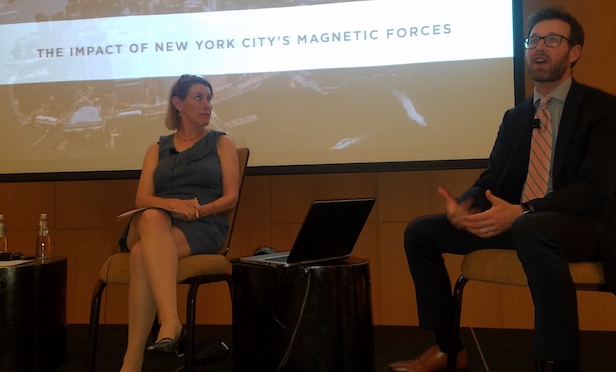 Kathryn Wylde, president and CEO of the Partnership for New York City/ Photo by Betsy Kim
Kathryn Wylde, president and CEO of the Partnership for New York City/ Photo by Betsy Kim
NEW YORK CITY—“New York is certainly at the top of the charts,” said Heidi Learner, chief economist at Savills.
Attracting a Mass Density
Learner continued that New York has the country's largest GDP at $1.7 trillion. In New York City including the surrounding metropolitan areas, there are 20 million people. That points to a diverse talent pool. “There's a host of culture. We have 41 Broadway theaters, 76 museums. It's a 24/7 city,” Learner said. “Where else can you literally get on a subway at 4 am and how many other cities can you get a bagel at 4 am as well?”
Learner joined Savills managing director Kevin Kelly and Kathryn Wylde, president and CEO of the Partnership for New York City, at the brokerage's speaking event about attracting people and businesses to the city. The themes could apply to what many cities are facing on different scales.
Kelly noted Savills' studies show urbanization is a major trend across the US and internationally. Within 30 minutes of the center of New York City, there has been a 5% growth of the talent base of people under 30 and a contraction of 5% of that demographic outside of it.
“It has only been in the last five or six years that our domestic in-migration of young people has been the source of our population growth,” said Wylde. “Before that it was immigration. But we saw in 2018 a 21% drop in foreign immigration, which seems to be pretty much of a threat to the future of New York.”
The Partnership was originally founded by David Rockefeller in 1979 to involve business leaders with the government to resolve crises facing New York City. Its membership includes almost 300 CEOs of top corporate and investment firms in the city. The organization invests in economic development projects throughout the boroughs.
However, Learner pointed out that from 2010 to 2018 in all five boroughs, births outweighed deaths. But the US is now at its lowest birth rate in 32 years. Although a younger demographic is growing in New York City, overall, domestic migration is negative in all five boroughs—including Manhattan. “Population growth is certainly something that is a challenge for New York City,” said Learner.
Part of the challenge is how expensive it is to live in the city with housing at the forefront, added Learner. Simply put, “We need more affordable housing,” she said.
Infrastructure and Education
The Partnership conducted a recent survey with foreign companies operating and making direct investments in New York City. “Their number one issue across the board was infrastructure, the reliability of the subways,” said Wylde. “We've seen a bit of focus and improvement on that but not enough to sustain us going forward. It's a serious issue going forward.”
 From left: Heidi Learner and Kevin Kelly/ Photo by Betsy Kim
From left: Heidi Learner and Kevin Kelly/ Photo by Betsy KimLearner also pointed out that the Gateway Project is still unresolved. That plan proposes replacing the tunnels that were severely damaged by Hurricane Sandy. These are the passageways used by Amtrak and New Jersey Transit to get to Midtown, through Penn Station. She warned attendees, “It's a big deal and so far, it is not funded. And those tunnels are supposed to collapse in 10 years.”
In addition, Kelly added that education remains one of the biggest challenges. As one example, Brooklyn has expanded immensely in terms of its density due to the influx of a younger population. “As cost has gone up from a rental perspective, the public education in some of those areas might be lagging behind where the rental cost exists today. That creates a difficulty when people start to enter family formations,” Kelly said.
Diversification of Economic Base, the Tech Influence
The panelists uniformly commented on how the city's economy has diversified from 10 to 15 years ago when it was dominated by financial services. The tech evolution is beyond coming. It's been here and is moving forward—the only question is how fast?
Learner said although finance still comprises the largest industry in terms of impact on New York City, there has been zero growth in the sector. She pointed out that in numbers financial services jobs are now at the same pre-recession levels. Although the TAMI sector still has fewer jobs compared to the finance sector, Learner emphasized the number of TAMI jobs has grown by 50%.
Technology has imbued virtually all industries. Wylde and Kelly pointed out now banks and insurance firms are describing themselves as tech companies. Even WeWork has called itself a tech company.
Bolstering the tech sector continues to be an urban economic strategy. It's one activated by cities not only across the country but around the world. Savills' latest global market report Impacts describes how tech cities are rising fast in China where the government sets out where it wants tech businesses to develop.
© Touchpoint Markets, All Rights Reserved. Request academic re-use from www.copyright.com. All other uses, submit a request to [email protected]. For more inforrmation visit Asset & Logo Licensing.







